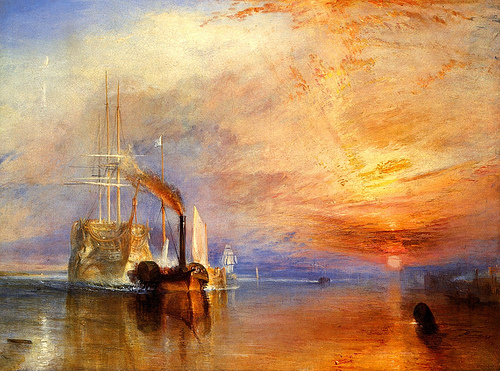On the eve of International Maritime Day, this week’s picture is J.M.W. Turner’s The Fighting Temeraire, tugged to her last Berth to be broken up, 1838. The painting depicts the last journey of the Temeraire, a 98-gun ship of the line made famous in 1805 by her part in the Battle of Trafalgar, where she had saved Nelson’s flagship the Victory by engaging two French ships simultaneously. “Nothing could be finer. I have not words in which I can sufficiently express my admiration of it,” wrote Admiral Collingwood at the time, describing the battle in his despatches to the Admiralty.
When Turner painted his picture Queen Victoria was on the throne and the Napoleonic Wars were receding into the collective memory of the nation. The Temeraire had become no more than a ghost ship. The artist shows her being tugged up river from Sheerness, where she had been moored for almost 20 years as a victualling ship, towards the shipbreaker’s yard where she was destined to be split up and sold off as timber. Turner’s contemporaries responded to the melancholy grandeur of his picture. Like the dark buoy so prominent in its foreground, his picture was seen as a kind of marker – an elegy to the heroic age of sail, painted at the very moment of its passing.
Ruskin’s friend, R.C. Leslie, was struck by Turner’s “strong, almost prophetic idea of smoke, soot, iron and steam, coming to the front in all naval matters”; while Thackeray addressed a gloomily effusive paean of praise to its creator. The Fighting Temeraire was, he said, “as grand a picture as ever figured on the walls of any academy, or came from the easel of any painter. The old Temeraire is dragged to her last home by a little, spiteful, diabolical...

ITP 75: The Fighting Temeraire, tugged to her last Berth to be broken up, 1838 by J.M.W. Turner
23-09-2001

